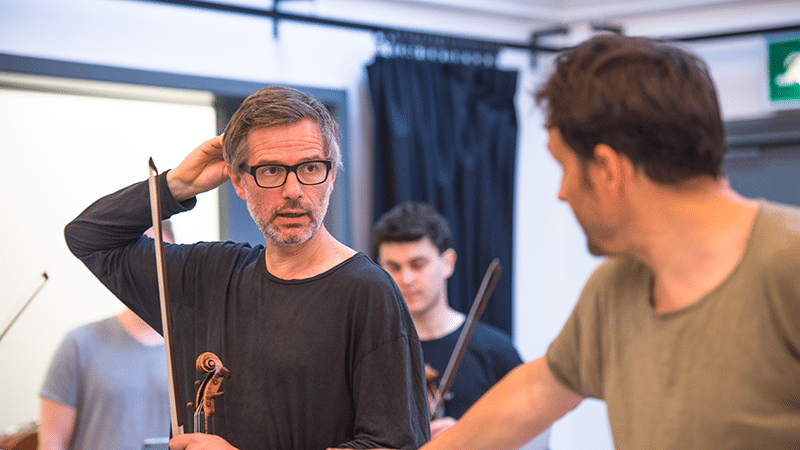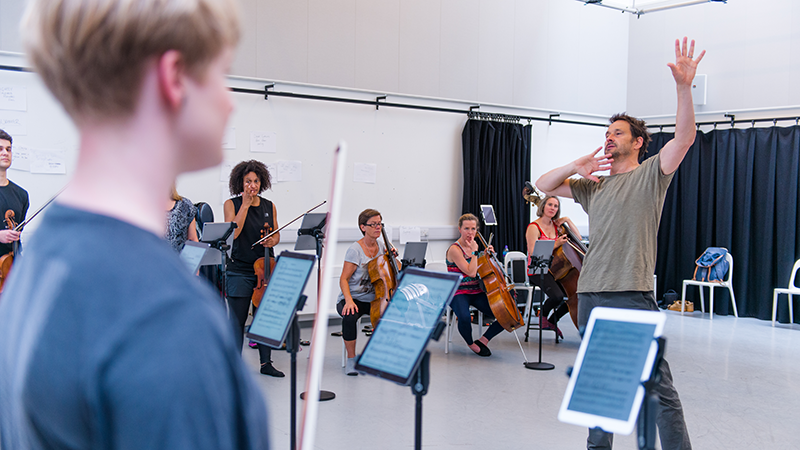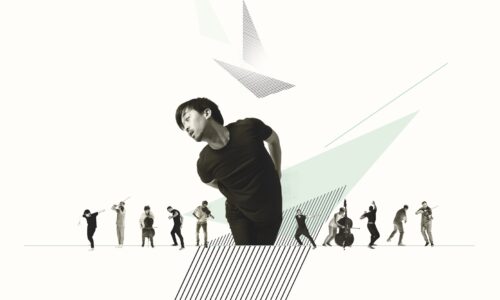1 November 2018

Jonathan Morton
Scottish Ensemble (SE): In a nutshell, what is Prelude – skydiving from a dream?
Jonathan: Prelude – skydiving from a dream is the second collaborative project between Scottish Ensemble and choreographer Örjan Andersson. We first collaborated together three years ago now, on a production based around Bach’s Goldberg Variations.
We decided to call this second one Prelude for all sorts of reasons but, as you might expect, it features a lot of preludes, which are short pieces of introductory music. And as preludes tend to go with fugues, so there’ll be quite a lot of fugues as well. There’ll be some by Johann Sebastian Bach, from his Art of Fugue, but the production really centres on Beethoven’s Grosse Fugue – an incredibly epic, titan-like piece of music which will end the show.
SE: How did you go about choosing which music to explore?
It was with a lot of instinct, really. I wanted to base the project around the Beethoven fugue, but I knew there would need to be something leading up to it, some sort of preparation, and that’s when I started thinking about preludes. Lutoslawski’s Preludes were an obvious choice to explore, as they had been in my mind for quite a few years, so I gradually built what I’m hoping will feel like a natural arch, with Bach in the middle.
That’s the musical idea, anyway – Örjan has then interpreted the music and, together, we’ve explored not just the musical elements but the metaphorical, the poetic, the narrative ideas that don’t fit into this strict musical structure, so that the music is enhanced by the choreography.
Beethoven - Gross Fugue, Op. 133
SE: What is the fascination with the Grosse Fugue?
Jonathan: What fascinates me about the all of the music in this project is that it’s not what you would call hugely popular repertoire. It’s certainly not easy listening, and I’m drawn – in a maybe slightly masochistic way – to the idea that I think it’s important to actually engage with this material and find a way through it, if we can. Rediscover it.
When Beethoven’s Grosse Fugue was premiered in his lifetime, there was a famous newspaper quote from the day which compared it to trying to understand a different language. It was called unintelligible. Chaotic. Gibberish. People just didn’t understand it and this label kept being applied to the piece – and, the really interesting thing is that although this piece has lived with us since its genesis, it’s never quite shed that label as being something apart, something aside from the rest of the composer’s output.
Stravinsky said it would forever be contemporary. It will never be anything but just extraordinarily modern. And that’s a really interesting idea and I think it’s true, but I don’t think that means that we can’t engage with it and that it has to remain this thing that’s a bit strange and we look at from a distance. Of course, it’s now become more accepted, but it’s still got that slight element of… it’s a very rebellious, quite extreme piece of music, and in a sense the Bach is similar. The Art of Fugue is a really intense exploration of counterpoint.
It’s my hope that in this production, we can break through this barrier of difficulty and try to find, with the choreography and all the other elements, some essence, some essential spirit that we’ll be able to communicate and share with an audience, so it becomes something very vital and absolutely visceral. That’s my hope, my ambition. We’ll see!
SE: As with the first Scottish Ensemble / Andersson Dance collaboration, Prelude sees musicians choreographed alongside trained dancers. What is your attraction to experimenting with this way of working?
Jonathan: The question of why we would, as musicians, want to move and be choreographed, is a very good one. From my point of view, as musicians, there’s a huge amount of gesture and movement in what we do already, before involving any actual choreography or dance. The physical act of playing any instrument is active – it involves a huge amount of coordination and physical control. And so for me, the movement we naturally make when we play is, somehow, linked very closely to the musical intention of both the composer and the musician performing his or her work.
Involving a choreographer is a way of opening that up a little bit more and making it more obvious. It’s quite a natural step and a big step at the same time, of course – there’s a difference between emphasising some of the things that we are doing naturally, and jumping across the stage…
But SE are quite a physical band anyway and there’s a lot of communication through movement, so it is absolutely part of what we do already.

Örjan Andersson
SE: What drew you to working with musicians as well as dancers?
Örjan: About 5 or 6 years ago, I started to work with different types of performers on stage, and it was like opening a door into a new world. I found, to my surprise, that I worked with these other performers in the same way that I did with professionally trained dancers – but something else comes out. A dancer will correct or fix; a non-dancer will not, and the results were something utterly new to me.
One is not better than the other, simply different. There is a different kind of sensitivity and vulnerability that occurs when working with the musicians, and there is something especially pleasing about mixing the two types – the schooled, and the un-schooled. To be able to have each performer, whether trained in music or in dance, on stage the whole time and choreograph each element remains a real thrill.
SE: What is the biggest challenge in working with people who are new to dance?
Örjan: One of the first things I do is to give them tasks that they must physically solve. For example, if you ask someone to make a sound, there’s naturally some movement involved. If you make two different sounds [Örjan stops to sweep his hands across the other] that comes with a choreography in itself.
The best thing about this sort of task is that the people doing it always surprise me in a different way because they don’t have the same aesthetic filter. When I give a task to a dancer, I know that they will fix it so it looks perfect – they have that history in their backpack, so to speak – but a musician does not. A musician can and will make things that are completely new to me – and that’s very thrilling.
